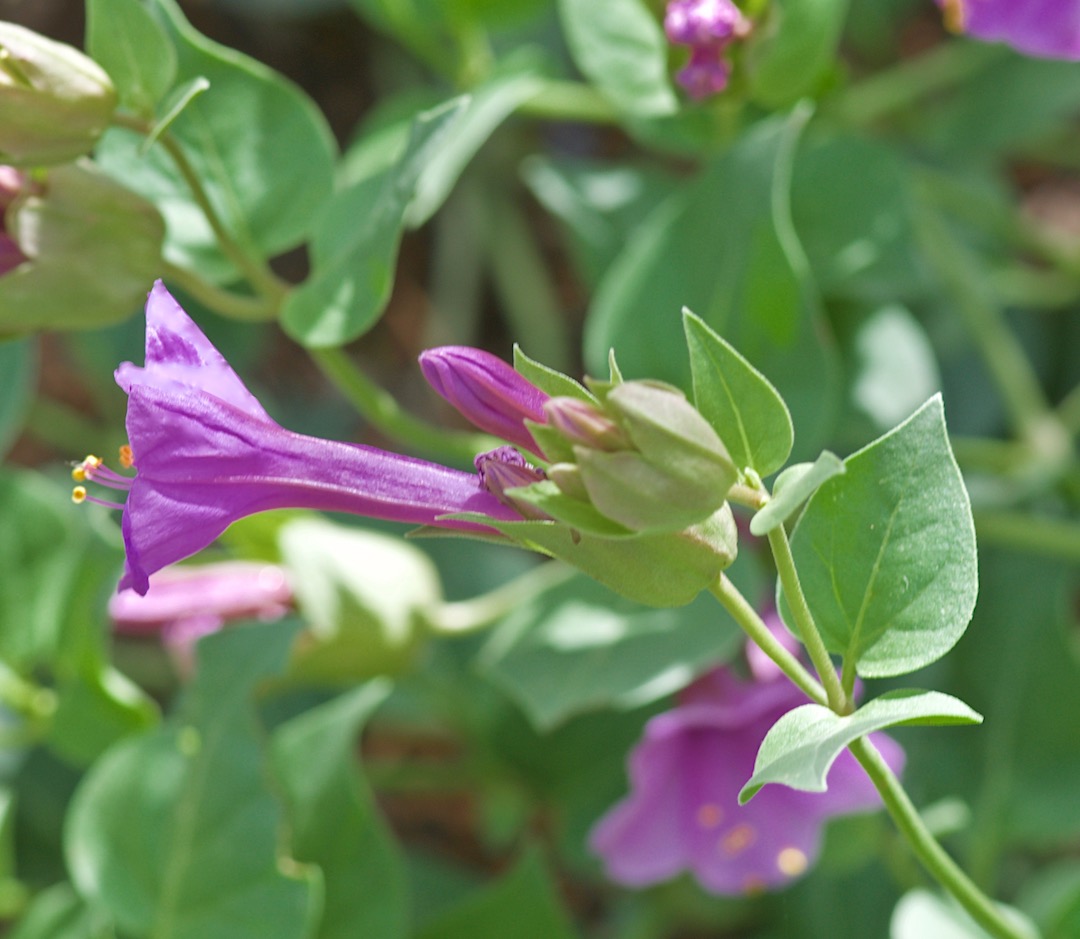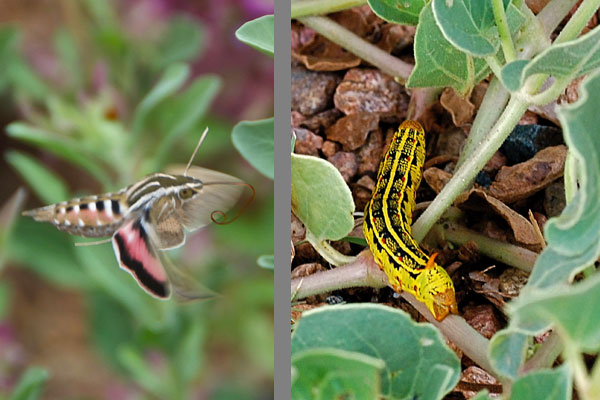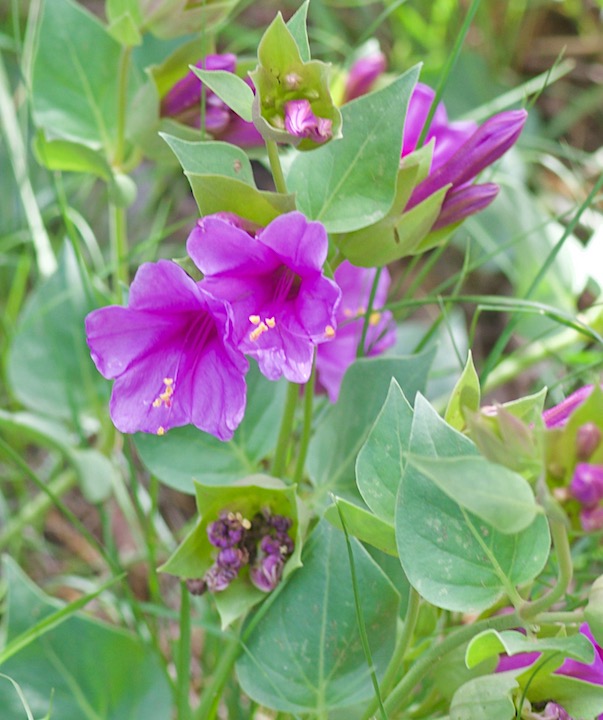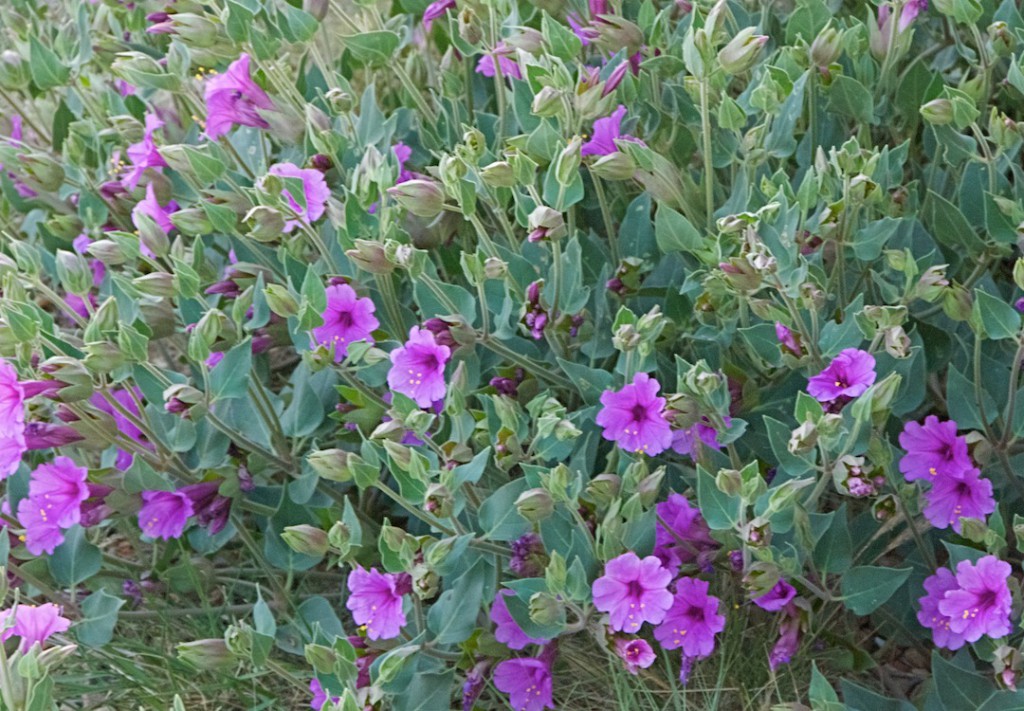Scientific name: Mirabilis multiflora

Mirabilis multiflora under a juniper (photo by Janice Tucker)
Common names: wild four o’clock, Colorado four o’clock, showy four o’clock,
desert four o’clock, Maravilla (Spanish)
Plant Family: Nyctaginaceae – Four o’clock (pronounced: nyk-taj-i-NAY-see-ee)
Article and photos by Janice Tucker
The showy wild four o’clock (Mirabilis multiflora) is the essence of bountiful beauty. Blanketing its foliage in an abundance of colorful flowers ranging from magenta to purple to deep pink, it exudes charm throughout the summer into fall.
The wild four o’clock is native to the Southwestern United States, Texas, a bit of Nebraska and Northern Mexico, adapting well to elevations ranging from 2,300 to 7,500 feet. Thanks to its large root that serves as a reservoir for nutrients and water, it has no problem with the arid environments of its native lands. It thrives in sunny, dry, shrubby upland areas where it can be seen growing among blue grama grass, keeping company with the likes of cholla and prickly pear cacti as well as juniper, chamisa and four-wing saltbush. But sometimes the wild four o’clock chooses to set down roots in partial shade beneath a tree in a woodland setting.

Mirabilis multiflora flower stamens and involucre cup (Photo by Janice Tucker)
The four o’clock is so called because like all plants in the Nyctaginaceace family, the flowers fully open late in the day. But don’t raise a fuss if they are still tightly curled inward at four p.m. It is the light – or rather dimming light – that triggers bloom time. And the sun is nowhere near ready to go to bed at four o’clock on a summer’s afternoon in New Mexico. The flowers usually remain in full bloom when it is overcast. However, on bright, sunshine-filled days, the trumpet-shaped flowers will begin to unfurl as the afternoon dissolves into dusk, staying open until the following morning.
In late spring or summer the wild four o’clock’s substantial root sends up leaves that rapidly develop into a low-growing shrub. Its lanky stems are adorned with opposite, green, heart-shaped or round leaves and hundreds of small cups consisting of modified leaves that develop at the leaf axils. These cups, often called involucres, contain 5 to 8 buds that open on successive days into trumpet-shaped, magenta-hued flowers with 5 fused sepals. Five yellow stamens extend just beyond the edge of the flowers. With a profusion of flowers constantly opening, there can be hundreds of blooms on one wild four o’clock plant at the same time, hence the specific name, multiflora.
It might seem that the wild four o’clock would need a good night’s rest after a day’s work of intense flower production. But, no, its day is not done. Come evening they are ready to entertain dinner guests! Those trumpet-shaped flowers open fully to herald the gathering darkness by releasing a seductive, musky scent that lures the pollinators of the night. The wild four o’clock primarily targets the Sphinx moth as a favorite but won’t turn other pollinators away. After sipping the tasty nectar stored in a flower’s deep throat, the stamens anoint departing pollinators with a dab of pollen to carry to other flowers.

Sphinx moth and Whitelined sphinx moth caterpillar on Mirabilis multiflora (Photos by Janice Tucker)

Mirabilis multiflora new and spent flowers and involucre ( photos by Janice Tucker)
Once pollinated, a flower will wither within the involucre until the sepals completely fall away to reveal oval, dark brown or black seeds. When all the flowers in the involucre cup have completed their life cycles, the cup will disintegrate, dispersing seeds in the hopes that they will go forth and multiply.
The wild four o’clock is a hearty soul but the first blast of chilly weather will put it to sleep for the winter. It may look dead but it isn’t. And then it will disappear from sight with nary a stem or leaf to indicate it was ever there. Not to worry. Only its fading foliage has bid us farewell. The wild four o’clock’s huge root just below the ground will spend the winter to rejuvenate. When spring arrives the wild four o’clock will emerge refreshed and prepared to charm us once again.
Even though the wild four o’clock thrives in its natural habitat, it also does quite well when intentionally planted in a home garden. Who can blame gardeners for finding a sunny morning spot with a bit of afternoon shade for this low-maintenance beauty? A word of advice if planting in the home garden: Either purchase the wild four o’clock as a bedding plant or try to grow it from seeds. Attempting to transplant it from the wild is next to impossible. Think of the blood, sweat and new swear words involved in digging up a root that is 2 feet deep and 1 foot around! Hardy in USDA Zones 4-8, the wild four o’clock will adapt to most soils with good drainage. Don’t even think about moving a wild four o’clock once it is comfortably ensconced in the flowerbed. Its root won’t take kindly to being relocated even if it could be dug up. Water well until established. After that no supplemental water is needed unless drought conditions prevail. Overwatering will result in a robust plant that produces lots of leaves but no flowers. A wild four o’clock with no flowers? What’s the point? The Botanical Garden at Museum Hill has included the wild four o’clock (Mirabilis multiflora) in its native plant collection located in the Ojos y Manos: Eyes and Hands garden addition. A visit to that area of the Garden will demonstrate how the wild four o’clock behaves in a planned landscape.
 Deer and rabbits don’t really care for the wild four o’clock – a big plus. Hummingbirds and butterflies may pay a visit before nightfall or in the morning hours while the flowers are still open.
Deer and rabbits don’t really care for the wild four o’clock – a big plus. Hummingbirds and butterflies may pay a visit before nightfall or in the morning hours while the flowers are still open.
With round-the-clock attention to flowering, luring pollinators and seed production, the wild four o’clock is the epitome of a well-defined work ethic wrapped up in the guise of a beautiful, ornamental plant. A hard worker and a beauty, it definitely deserves the generic Latin name of Mirabilis, which means: Marvelous.
Thanks to Helen Woody and Jeanne Gozigian for proofreading this article.
Sources Consulted:
The American Southwest website: Nyctaginaceae Wildflowers
Curtin, Leonora Scott Muse: Healing Herbs of the Upper Rio Grande: Mirabilis multiflora
High Country Gardens website: Mirabilis multiflora – Wild Four O’clock
Lady Bird Johnson Wildflower Center website: Mirabilis multiflora
National Audubon Society: Field Guide to Wildflowers – Western Region: Mirabilis multiflora
Phillips, Judith: New Mexico’s Gardener’s Guide: Mirabilis multiflora
Schneider, Al, southwestcoloradowildflowers.com website: Mirabilis multiflora
SEINet, Arizona chapter website: Mirabilis multiflora
Stearn, William T.: Stearn’s Dictionary of Plant Names for Gardeners
USDA Forest Service website: Colorado Four o’clock (Mirabilis multiflora)
U.S. National Plant Germplasm System (GRIN) – Mirabilis multiflora


